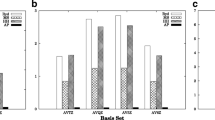Abstract
For the first time, a 15-dimensional analytical form was obtained and the potential energy of the SF6 molecule in the ground electronic state was found. An optimal grid of geometries was constructed, which, taking into account the full symmetry of the molecule, unambiguously determines the potential energy surface of the sixth order. Using the MP2 method with the cc-pVTZ base set, the potential energy surface of the fourth order was calculated.



Similar content being viewed by others
REFERENCES
S. Jesse, A. J. Pedraza, and J. D. Fowlkes, “Etching-enhanced ablation and the formation of a microstructure in silicon by laser irradiation in an SF6 atmosphere,” J. Mater. Res., No. 17, 1002–1013 (2002).
W. M. Johnstone and W. R. Newell, “Absolute elastic differential cross sections for electron scattering from SF6,” J. Phys. B, No. 24, 473–487 (1991).
N. H. Malik and A. H. Qureshi, “A review of electrical breakdown in mixtures of SF6 and other gases,” IEEE Trans. Electr. Insul. 14 (1), 11–13 (1979).
O. Hodnebrog, M. Etminan, J. S. Fuglestvedt, G. Marston, G. Myhre, C. J. Nielsen, K. P. Shine, and T. J. Wallington, “Global warming potentials and radiative efficiencies of halocarbons and related compounds: A comprehensive review,” Rev. Geophys. 51 (2), 300–378 (2013).
A. R. Ravishankara, S. Solomon, A. A. Turnipseed, and R. F. Warren, “Atmospheric lifetimes of long-lived halogenated species,” Science 259 (5092), 194–199 (1993).
www.esrl.noaa.gov/?gmd/?hats/?data.html. Cited March 17, 2019.
M. Rey, I. S. Chizhmakova, A. V. Nikitin, and V. G. Tyuterev, “Understanding global infrared opacity and hot bands of greenhouse molecules with low vibrational modes from first-principles calculations: The case of CF4,” Phys. Chem. Chem. Phys. 20, 21008–21033 (2018).
V. Boudon and D. Bermejo, “First high-resolution Raman spectrum and analysis of the ν5,” J. Mol. Spectrosc. 213, 139–144 (2002).
V. Boudon, G. Pierre, and H. Burger, “High-resolution spectroscopy and analysis of the n 4 bending region of SF6 near 615 cm–1,” J. Mol. Spectrosc. 205, 304–311 (2001).
G. Nagarajan and D. C. Brinkley, “Statistical thermodynamics enthalpy, free energy, entropy, and heat capacity of some hexafluorides of octahedral symmetry,” Z. Naturforsch., A: Phys. Sci., 1658–1665 (1971).
V. P. Spiridonov, Y. I. Tarasov, B. K. Novosadov, O. Y. Nikitin, and I. V. Maslov, “A practical method for diffraction analysis of equilibrium geometries molecules without refined force fields,” J. Mol. Struct., 463–470 (1997).
H. -J. Werner, P. J. Knowles, G. Knizia, F. R. Manby, M. Schutz, P. Celani, W. Gyorffy, D. Kats, T. Korona, R. Lindh, A. Mitrushenkov, G. Rauhut, K. R. Shamasundar, T. B. Adler, R. D. Amos, S. J. Bennie, A. Bernhardsson, A. Berning, D. L. Cooper, M. J. O. Deegan, A. J. Dobbyn, F. Eckert, E. Goll, C. Hampel, A. Hesselmann, G. Hetzer, T. Hrenar, G. Jansen, C. Koppl, S. J. R. Lee, Y. Liu, A. W. Lloyd, Q. Ma, R. A. Mata, A. J. May, S. J. McNicholas, W. Meyer, T. F. III. Miller, and M. E. Mura, MOLPRO, version 2009.1, a package of ab initio programs. http://www.molpro.net. Cited March, 17, 2019.
R. J. Bartlett, “Many-body perturbation theory and coupled cluster theory for electron correlation in molecules,” Ann. Rev. Phys. Chem. 32, 359–401 (1981).
M. Head-Gordon, J. A. Pople, and M. J. Frisch, “MP2 energy evaluation by direct methods,” Chem. Phys. Lett. 153 (6), 503–506 (1988).
W. Eisfeld, “Highly accurate determination of the electron affinity of SF6 and analysis of structure and photodetachment spectrum of SF6,” J. Chem. Phys., No. 134, 054303 (2011).
B. R. Miller and M. Fink, “Mean amplitudes of vibration of SF6 and intramolecular multiple scattering,” J. Chem. Phys., No. 75, 5326–5328 (1981).
A. V. Nikitin, M. Rey, and V. G. Tyuterev, “Rotational and vibrational energy levels of methane calculated from a new potential energy surface,” Chem. Phys. Lett. 501, 179–186 (2011).
A. V. Nikitin, “Calculation of vibrational energy levels of symmetric molecules from potential energy surface,” Opt. Atmos. Okeana 28 (5), 379–390 (2015).
B. I. Zhilinskii, V. I. Perevalov, and V. G. Tyuterev, Method of Irreducible Tensorial Operators in the Theory of Molecular Spectra (Nauka, Novosibirsk, 1987), p. 1–13 [in Russian].
L. Halonen and M. S. Child, “A local mode model for tetrahedral molecules,” Mol. Phys. 46, 239–255 (1982).
P. N. Schatz and D. F. Hornig, “Bond moments and derivatives in CF4, SiF4, and SF6 from infrared intensities,” J. Chem. Phys. 21 (9), 1516–1530 (1953).
M. Fernandez-Gomez and J. J. Lopez-Gonzalez, “Calculation of internal valence force constants for XY6(Oh) octahedral molecules,” J. Mol. Struct. 220, 287–300 (1990).
T. C. W. F. Pistorius, “Potential field and force constants of octahedral molecules,” J. Chem. Phys. 29 (6), 1328–1332 (1958).
V. G. Tyuterev, S. A. Tashkun, M. Rey, R. V. Kochanov, A. V. Nikitin, and T. Delahaye, “Accurate spectroscopic models for methane polyads derived from a potential energy surface using high-order contact transformations,” J. Phys. Chem. 117, 13779–13805 (2013).
M. Rey, A. V. Nikitin, Y. Babikov, and V. G. Tyuterev, “TheoReTS—An information system for theoretical spectra based on variational predictions from molecular potential energy and dipole moment surfaces,” J. Mol. Spectrosc. 327, 138–158 (2016).
Funding
The work was supported by the Russian Science Foundation (grant no. 17-17-01170).
Author information
Authors and Affiliations
Corresponding authors
Ethics declarations
The authors declare that they have no conflicts of interest.
Additional information
Translated by O. Ponomareva
Rights and permissions
About this article
Cite this article
Chizhmakova, I.S., Nikitin, A.V. Potential Energy Surface of SF6. Atmos Ocean Opt 32, 613–618 (2019). https://doi.org/10.1134/S1024856019060046
Received:
Revised:
Accepted:
Published:
Issue Date:
DOI: https://doi.org/10.1134/S1024856019060046




